Solution
In the space of all lines in the graph, the lines which pass by a corner are exactly the ones where the number or intersections is about to decrease. In other words, they each form a local maximum.
And for every line which passes by at least one corner, there exist an associated line that passes by two corners that has the same number of intersections.
The conclusion is that we only need to check the lines formed by two rectangle corners as they form a set that fully represents the local maxima of our problem. From those we pick the one which has the most intersections.
Time complexity
This solution first needs to recovers all lines that pass by two corners. The number of such line is O(n^2).
We then need to count the number of intersections between a given line and a rectangle. This can obviously be done in O(n) by comparing to each rectangles.
There might be a more efficient way to proceed, but we know that this algorithm is then at most O(n^3).
Python3 implementation
Here is a Python implementation of this algorithm. I oriented it more toward readability than efficiency, but it does exactly what the above defines.
def get_best_line(rectangles):
"""
Given a set of rectangles, return a line which intersects the most rectangles.
"""
# Recover all corners from all rectangles
corners = set()
for rectangle in rectangles:
corners |= set(rectangle.corners)
corners = list(corners)
# Recover all lines passing by two corners
lines = get_all_lines(corners)
# Return the one which has the highest number of intersections with rectangles
return max(
((line, count_intersections(rectangles, line)) for line in lines),
key=lambda x: x[1])
This implementation uses the following helpers.
def get_all_lines(points):
"""
Return a generator providing all lines generated
by a combination of two points out of 'points'
"""
for i in range(len(points)):
for j in range(i, len(points)):
yield Line(points[i], points[j])
def count_intersections(rectangles, line):
"""
Return the number of intersections with rectangles
"""
count = 0
for rectangle in rectangles:
if line in rectangle:
count += 1
return count
And here are the class definition that serve as data structure for rectangles and lines.
import itertools
from decimal import Decimal
class Rectangle:
def __init__(self, x_range, y_range):
"""
a rectangle is defined as a range in x and a range in y.
By example, the rectangle (0, 0), (0, 1), (1, 0), (1, 1) is given by
Rectangle((0, 1), (0, 1))
"""
self.x_range = sorted(x_range)
self.y_range = sorted(y_range)
def __contains__(self, line):
"""
Return whether 'line' intersects the rectangle.
To do so we check if the line intersects one of the diagonals of the rectangle
"""
c1, c2, c3, c4 = self.corners
x1 = line.intersect(Line(c1, c4))
x2 = line.intersect(Line(c2, c3))
if x1 is True or x2 is True \
or x1 is not None and self.x_range[0] <= x1 <= self.x_range[1] \
or x2 is not None and self.x_range[0] <= x2 <= self.x_range[1]:
return True
else:
return False
@property
def corners(self):
"""Return the corners of the rectangle sorted in dictionary order"""
return sorted(itertools.product(self.x_range, self.y_range))
class Line:
def __init__(self, point1, point2):
"""A line is defined by two points in the graph"""
x1, y1 = Decimal(point1[0]), Decimal(point1[1])
x2, y2 = Decimal(point2[0]), Decimal(point2[1])
self.point1 = (x1, y1)
self.point2 = (x2, y2)
def __str__(self):
"""Allows to print the equation of the line"""
if self.slope == float('inf'):
return "y = {}".format(self.point1[0])
else:
return "y = {} * x + {}".format(round(self.slope, 2), round(self.origin, 2))
@property
def slope(self):
"""Return the slope of the line, returning inf if it is a vertical line"""
x1, y1, x2, y2 = *self.point1, *self.point2
return (y2 - y1) / (x2 - x1) if x1 != x2 else float('inf')
@property
def origin(self):
"""Return the origin of the line, returning None if it is a vertical line"""
x, y = self.point1
return y - x * self.slope if self.slope != float('inf') else None
def intersect(self, other):
"""
Checks if two lines intersect.
Case where they intersect: return the x coordinate of the intersection
Case where they do not intersect: return None
Case where they are superposed: return True
"""
if self.slope == other.slope:
if self.origin != other.origin:
return None
else:
return True
elif self.slope == float('inf'):
return self.point1[0]
elif other.slope == float('inf'):
return other.point1[0]
elif self.slope == 0:
return other.slope * self.origin + other.origin
elif other.slope == 0:
return self.slope * other.origin + self.origin
else:
return (other.origin - self.origin) / (self.slope - other.slope)
Example
Here is a working example of the above code.
rectangles = [
Rectangle([0.5, 1], [0, 1]),
Rectangle([0, 1], [1, 2]),
Rectangle([0, 1], [2, 3]),
Rectangle([2, 4], [2, 3]),
]
# Which represents the following rectangles (not quite to scale)
#
# *
# *
#
# ** **
# ** **
#
# **
# **
We can clearly see that an optimal solution should find a line that passes by three rectangles and that is indeed what it outputs.
print('{} with {} intersections'.format(*get_best_line(rectangles)))
# prints: y = 0.50 * x + -5.00 with 3 intersections




